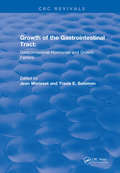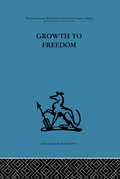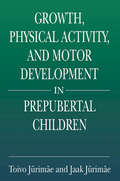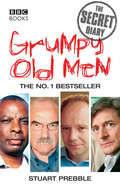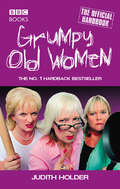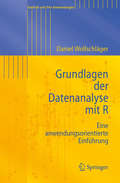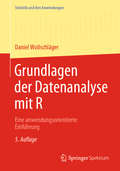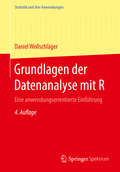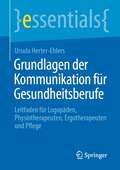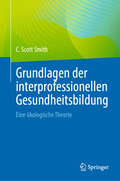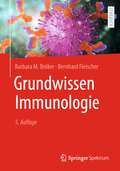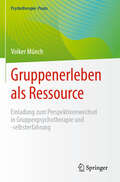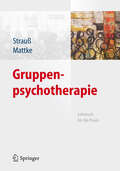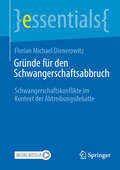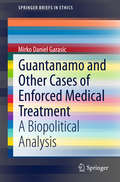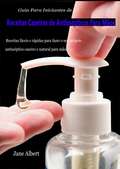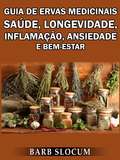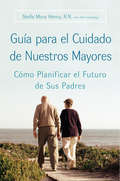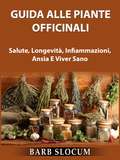- Table View
- List View
Growth of the Gastrointestinal Tract (CRC Press Revivals)
by Jean A. Morisset Travis E. SolomonThis book provides an up-to-date summary of the large body of data regarding gastrointestinal hormones and growth factors involved in the development and maintenance of the architecture and physiological functions of the different organs of the digestive tract. The regulation of growth and differentiation in the stomach, small intestine, colon, and pancreas is reviewed by experts in developmental and adult physiology, as well as in pathophysiology of diseases involving each organ. The book provides essential reference material for gastroenterologists, medical and university libraries, and investigators and graduate students of gastrointestinal physiology.
Growth to Freedom: The Psychosocial Treatment of Delinquent Youth
by Derek MillerTavistock Press was established as a co-operative venture between the Tavistock Institute and Routledge & Kegan Paul (RKP) in the 1950s to produce a series of major contributions across the social sciences. This volume is part of a 2001 reissue of a selection of those important works which have since gone out of print, or are difficult to locate. Published by Routledge, 112 volumes in total are being brought together under the name The International Behavioural and Social Sciences Library: Classics from the Tavistock Press. Reproduced here in facsimile, this volume was originally published in 1964 and is available individually. The collection is also available in a number of themed mini-sets of between 5 and 13 volumes, or as a complete collection.
Growth, Physical Activity, and Motor Development in Prepubertal Children
by Toivo Jurimae Jaak JurimaeThe tender period between childhood and adolescence is full of changes for young children. They are approaching the onset of sexual maturation, and because they are beginning their school careers, the possibilities for voluntary play and movement rapidly decrease while mental stress rapidly increases. It is very important that young children have a
Grumpy Old Men: The Secret Diary
by Stuart PrebbleTo everything there is a season. A time to be born, a time to die ... and a time to have a bloody good moan. Following the huge success of Grumpy Old Men, Stuart Prebble, writer of the highly acclaimed TV series, gives us a more in-depth look at what it's really like to be a pissed-off man of a certain age. In painstaking detail, he takes us through a year in the constantly irritated life of a Grumpy Old Man, recounting the manifold vexations and absurdities he has to put up with in the perpetual torment that we call modern living. Drinks parties, holidays, hospital visits, his children's misdemeanours, buying presents for the wife, watching television, attempts to visit the gym, trips to the shops, the trials and tribulations of everyday life - each event has something to tip him over the edge. Stuart's diary proves that grumpiness is not just an occasional mood or a temporary feeling, but a way of looking at the world, and will strike a chord with all those who are proud to call themselves Grumpy Old Men.
Grumpy Old Women
by Judith HolderWe all know what it means these days to be a grumpy old man, because part of that role is to be outspoken. Well, we've heard just about enough out of the men, thank you very much! Grumpy Old Women gives us the other perspective: the female take on the million irritations of today's world. So whats the difference? Surely what is irritating to the mature members of one sex is equally annoying to the other? Not necessarily, and this is precisely what Grumpy Old Women seeks to address. Body image, visitors, children, animals, shopping, careers, parties, holidays and, yes, grumpy old men themselves all are very much on the list of what today's mature woman finds a source of concern. From the series producer and stand-up comic Judith Holder, the book incorporates material from the television series Grumpy Old Women, which features a diverse, colourful and very grumpy group of celebrities, including Janet Street Porter, Jenny Eclair, Ann Widdecombe, Germaine Greer, Kathryn Flett and Jilly Cooper. Written with wit, style and sympathy, the book is a source of both amusement and comfort to women everywhere - grumpy, old or otherwise.
Grundlagen der Datenanalyse mit R
by Daniel WollschlägerDieses Buch liefert eine anwendungsorientierte Einführung in die Grundlagen der Datenauswertung mit dem freien Statistikpaket R. Es behandelt deskriptive Auswertungen ebenso wie inferenzstatistische Analysen. Neben den geläufigsten univariaten Verfahren berücksichtigt es nonparametrische sowie ausgewählte multivariate Methoden. Zudem deckt es die vielfältigen Möglichkeiten ab, Diagramme zu erstellen und Daten mit anderen Programmen auszutauschen. Die statistischen Verfahren werden an Beispielen erläutert und an vielen Stellen mit Diagrammen illustriert. Hinzu kommen manuelle Kontrollrechnungen, um die Ergebnisse von R Schritt für Schritt nachvollziehbar zu machen. Das Buch richtet sich an alle, die R kennenlernen und in konkreten Aufgabenstellungen einsetzen möchten, ohne bereits über Vorerfahrungen mit befehlsgesteuerten Programmen oder Programmiersprachen zu verfügen.
Grundlagen der Datenanalyse mit R: Eine anwendungsorientierte Einführung (Statistik und ihre Anwendungen)
by Daniel WollschlägerDieses Buch liefert eine anwendungsorientierte Einführung in die Datenauswertung mit der freien Statistikumgebung R. Es behandelt deskriptive Auswertungen ebenso umfassend wie inferenzstatistische Analysen. Neben klassischen univariaten Verfahren berücksichtigt das Buch nonparametrische Tests, Resampling-Methoden und multivariate Statistik. Zudem deckt es die vielfältigen Möglichkeiten ab, Daten aufzubereiten und Diagramme zu erstellen. Die statistischen Verfahren werden anhand von Beispielen erläutert und an vielen Stellen mit Diagrammen illustriert. Das Buch richtet sich an alle, die R kennenlernen und in konkreten Aufgabenstellungen einsetzen möchten, ohne bereits über Vorerfahrungen mit befehlsgesteuerten Programmen oder Programmiersprachen zu verfügen. Für die fünfte Auflage wurde das Buch vollständig aktualisiert: Es bezieht sich nun auf die Version 4.0.0 von R, auch die Auswahl und Darstellung verwendeter Zusatzpakete wurde der dynamischen Entwicklung angepasst. Außerdem wurde insbesondere der Abschnitt zur Datenaufbereitung überarbeitet: Zur stärkeren Ausrichtung auf Data-Science-Anwendungen stellt er nun ausführlich das Paket dplyr vor, enthält eine erweiterte Darstellung von R-Markdown-Dokumenten und bespricht Hinweise zur Reproduzierbarkeit von Auswertungen.
Grundlagen der Datenanalyse mit R: Eine anwendungsorientierte Einführung (Statistik und ihre Anwendungen)
by Daniel WollschlägerDieses Buch liefert eine anwendungsorientierte Einführung in die Datenauswertung mit der freien Statistikumgebung R. Es behandelt deskriptive Auswertungen ebenso umfassend wie inferenzstatistische Analysen. Neben klassischen univariaten Verfahren berücksichtigt das Buch nonparametrische Tests, Resampling-Methoden und multivariate Statistik. Zudem deckt es die vielfältigen Möglichkeiten ab, Daten aufzubereiten und Diagramme zu erstellen. Die statistischen Verfahren werden anhand von Beispielen erläutert und an vielen Stellen mit Diagrammen illustriert.Das Buch richtet sich an alle, die R kennenlernen und in konkreten Aufgabenstellungen einsetzen möchten, ohne bereits über Vorerfahrungen mit befehlsgesteuerten Programmen oder Programmiersprachen zu verfügen. In die vierte Auflage sind sowohl die Neuerungen von R 3.3.2 als auch jüngere Entwicklungen bei den Zusatzpaketen eingeflossen. Gleichzeitig wurde der Text überarbeitet und um ein eigenes Kapitel zu Diagrammen mit ggplot2 erweitert. Der Text behandelt nun auch allgemeine numerische Methoden wie Nullstellensuche, numerische Integration und Ableitung sowie numerische Optimierung.
Grundlagen der Gesundheitsökonomie: Eine Einführung in das wirtschaftliche Denken im Gesundheitswesen
by Steffen Fleßa Wolfgang GreinerAuch wenn ressourcenbewusstes Handeln für Mitarbeiter im Gesundheitswesen schon immer selbstverständlich war, die Notwendigkeit einer Ausbildung in Ökonomik gelangte erst durch gesetzliche Sparmaßnahmen ins Bewusstsein. Das Lehrbuch bietet eine praxisnahe, umfassende und dabei kompakte Einführung in betriebs- und volkswirtschaftliche Zusammenhänge. So wird die Gesundheitsökonomik zu einem hilfreichen Instrument für Ärzte, Pflegekräfte und andere Mitarbeiter. Für die Neuauflage wurde die Darstellung der gesetzlichen Rahmenbedingungen aktualisiert.
Grundlagen der Kommunikation für Gesundheitsberufe: Leitfaden für Logopäden, Physiotherapeuten, Ergotherapeuten und Pflege (essentials)
by Ursula Herter-EhlersDieses essential zeigt Logopäden, Physiotherapeuten, Ergotherapeuten und Pflegefachkräften, welche kommunikativen Kompetenzen für eine professionelle Kommunikation im Berufsalltag notwendig sind. Fokussiert, übersichtlich, unkompliziert und verständlich sind alle wesentlichen Aspekte abgedeckt, die für eine erfolgreiche Kommunikation mit Patienten, Klienten und Angehörigen wichtig sind. Im Mittelpunkt stehen die professionelle Gestaltung von Kommunikationssituationen, der gezielte Einsatz von Gesprächsführungstechniken und die Reflexion der Gespräche mit dem Einschätzungsbogen „Kommunikative Kompetenzen“.
Grundlagen der interprofessionellen Gesundheitsbildung: Eine ökologische Theorie
by C. Scott SmithDieses Buch führt in eine Theorie der ökologischen Psychologie innerhalb der interprofessionelle Gesundheitsbildung ein. Die Grundlagen sind Affordanzen (Merkmale der Umgebung, die die Möglichkeit bieten, erkannt und genutzt zu werden), die Lebenswelt (was die bedeutungsvolle Umgebung für den Lernenden enthält) und Verhaltenssettings (von Menschen geschaffene Affordanzen, die spezifische Verhaltensweisen erlauben, unterstützen oder dagegenwirken). Die Erweiterung der Lebenswelt ist der Hauptmechanismus des Lernens im Gesundheitswesen. Das Bewusstsein für absichtliche und unbeabsichtigte Merkmale des Verhaltenssettings hilft uns, die curriculare Umgebung zu strukturieren, um diese Erweiterung der Lebenswelt zu erreichen. Das Buch ist in vier Aspekte unterteilt: der natürliche Aspekt, der mentale Aspekt, der soziale Aspekt und die Nichtlinearität. Der abschließende Anwendungsteil bietet eine Struktur für die Gestaltung, Implementierung und Evaluation des Bildungsprogramms in einem professionellen Gesundheitsumfeld. Dieses Buch ist ideal für Gesundheitsmanager interprofessioneller Gesundheitseinrichtungen sowie für Lehrende und Studierende aus verschiedenen Disziplinen, z. B. Medizin, Pflege, Pharmazie, Psychologie, Sozialarbeit.
Grundlagen von Sport und Sportwissenschaft: Handbuch Sport und Sportwissenschaft
by Arne Güllich Michael KrügerDieses Handbuch bietet einen kompletten Überblick über zentrale Themen der Sportwissenschaft. Es richtet sich an das breite Publikum der Fachleute, Lehrenden und Wissenschaftler*innen im Sport. Hier können Sie sich kompakt und kompetent über den Stand der Wissenschaft und der Kultur des Sports informieren. Das Handbuch ersetzt bisherige Lexika und Handbücher zum Sport.Die Texte sind verständlich formuliert und anschaulich aufbereitet. Die über 30 Kapitel in diesem Grundlagenband geben Ihnen den aktuellsten wissenschaftlichen Stand zur Sportwissenschaft und ihren Grundthemen, Kultur und Geschichte des Sports, Theorie und Praxis der Sportarten und Bewegungsfelder. Zudem erhalten Sie Hinweise auf die wichtigste nationale und internationale Forschungsliteratur.
Grundwissen Immunologie
by Bernhard Fleischer Barbara M. BrökerDieses bereits in 5. Auflage erfolgreiche Kurzlehrbuch der Immunologie erläutert die Vielfalt molekularer und zellbiologischer Mechanismen von Immunreaktionen bei Mensch und Tier. Es wird erklärt, was das Immunsystem bei der Infekt- und Tumorabwehr oder bei einer Schwangerschaft leistet und wie Allergien und Autoimmunkrankheiten entstehen können. Immunologische Therapiestrategien bei Tumoren, Allergien und Autoimmunkrankheiten sowie die Wirkungsweise von Impfungen werden erörtert. Kurze Beschreibungen von wichtigen Arbeitsmethoden dienen als Blick in die Praxis. Fragen führen durch das Buch, und MEMO-Boxen fassen wichtige Punkte zusammen. Schließlich finden Leserinnen und Leser im Anhang interessante "Fakten und Zahlen".Studierende und Berufstätige aller biologischen, biochemischen, medizinischen, pharmazeutischen und veterinärmedizinischen Fachrichtungen sind besonders angesprochen. Das Buch soll ihr Interesse für die Immunologie wecken und das Verstehen erleichtern.
Grundwissen Soziale Arbeit: Grundlagen, Methoden und Arbeitsfelder (FOM-Edition)
by Matthias Buntrock Katharina PeinemannDas Buch behandelt beispielhaft das gesamte Themenspektrum der Sozialen Arbeit. Es vermittelt allgemeine Grundlagen, zeigt das methodische Vorgehen, liefert Hinweise für das wissenschaftliche Arbeiten, gibt Einblicke in die Tätigkeitsfelder und diskutiert spezifische Fachfragen der Disziplin Soziale Arbeit.Autoren sind Professoren und Dozenten der FOM sowie ausgewählte Experten, die sich in ihren Beiträgen an den Modulen orientierten, die sie in der Lehre seit vielen Semestern vertreten. Somit fließen die Erfahrungen und Rückmeldungen der Studierenden in die Erstellung der Beiträge mit ein. Das Buch soll den Studierenden der Sozialen Arbeit Hilfestellung bei der Vor- und insbesondere Nachbereitung der entsprechenden Module bieten aber auch generell zu Anleitung und zum Verständnis der Wissenschaft Sozialer Arbeit in Theorie und Praxis dienen.Es kann zugleich als Nachschlagewerk und zum Selbststudium herangezogen werden.
Gruppenerleben als Ressource: Einladung zum Perspektivenwechsel in Gruppenpsychotherapie und -selbsterfahrung (Psychotherapie: Praxis)
by Volker MünchDieses Fachbuch für Psychotherapeuten und Gruppentherapeuten regt den Leser, die Leserin entlang des eigenen Lebenslaufs an, eigene Gruppenerfahrungen neu zu reflektieren – und diese Einsichten in Beziehung zu Therapieprozessen zu setzen. Psychisches Leben und persönliche Entwicklung entsteht immer in Netzwerken. Analytische Gruppentherapie nutzt dies und macht psychische Vorgänge sichtbar, die in Einzelbehandlungen zu oft unklar bleiben. Unser Bild der psychischen Entwicklung des Menschen wandelt sich angesichts neurowissenschaftlicher Erkenntnisse und vor dem Hintergrund komplexer gesellschaftlicher Herausforderungen unserer Zeit in ein Bild des Menschen als Social Animal. Wir sehen einen Aufschwung für die Gruppentherapie und eine Öffnung gegenüber Theorien, die unsere gegenseitige Abhängigkeit in einem positiven Sinn betonen. Zusammengehörigkeit und Solidarität können so gemeinschaftlich eingeübt werden und transformatorische Kraft für Veränderung beim Einzelnen, aber auch für dieGesellschaft entfalten. Viele lebensnahe Beispiele vor allem aus therapeutischen Gruppen illustrieren dies. Geschrieben für:Psychotherapeut*innen, Gruppenpsychotherapeut*innen, Gruppenleiter*innen im medizinischen und sozialen Bereich.Über den Autor: Dipl. Psych. Volker Münch, Psychologischer Psychotherapeut in eigener Praxis in München. Lehranalytiker, Supervisor und Dozent an der MAP, München. Veröffentlichungen zu den Themen Therapeutische Haltung, Digitalisierung, Krise in der Lebensmitte.
Gruppenpsychotherapie
by Bernhard Strauß Dankwart MattkeGruppenpsychotherapie ist eine anerkannte Methode der Anwendung aller wichtigen Psychotherapieverfahren, das die in einer Gruppe auftretenden speziellen Gruppenphänomene für die Psychotherapie einsetzt. Sie findet Einsatz im ambulanten, teilstationären und stationären Setting und dient auch als Unterstützung bei vielfältigen psychosozialen Konfliktfeldern. Dieses Buch versteht sich als Lehrbuch für die Praxis: Fachleute aus den jeweiligen Anwendungsfeldern stellen die relevanten theoretischen Informationen und Handlungsempfehlungen für die Arbeit in verschiedenen Settings und bei den Störungsbildern dar.
Gründe für den Schwangerschaftsabbruch: Schwangerschaftskonflikte im Kontext der Abtreibungsdebatte (essentials)
by Florian Michael DienerowitzDieses essential bietet einen Überblick über vorliegende Forschungsdaten zu den Gründen des Schwangerschaftskonflikts und präsentiert eine detaillierte aktuelle Studie sowie den zugehörigen standardisierten Erfassungsansatz. In knapper Form sind geschichtliche, rechtliche und ethische Aspekte der kontroversen Abtreibungsdebatte dargestellt. Der Schwangerschaftsabbruch ist mit jährlich über 100.000 in Deutschland erfassten Abbrüchen eine häufige gynäkologische Intervention, den zugrundeliegenden vielfältigen Konfliktgründen wurde jedoch bisher nur wenig Beachtung geschenkt. Das essential bietet hier Aufklärung und schließt mit einigen Schlussfolgerungen für die Praxis und Rechtspolitik.
Grüne Stadt - Gesunder Mensch: Herausforderungen, Lösungsansätze und Handlungsfelder (essentials)
by Pamela Heise Silja HallermayrDas Leben in der Stadt kann zu physischen und psychischen Erkrankungen führen. Dabei spielen Umweltfaktoren, wie z.B. Extremwetterereignisse, Luftverunreinigung, Lärmbelastung oder veränderte Stadtklimatologie durch Versiegelung eine entscheidende Rolle.Ein grünes Stadtbild kann durch die Schaffung gesundheits- und bewegungsfördernder Strukturen die Gesundheit und das Wohlbefinden der Bürger positiv beeinflussen und damit Krankheiten, die durch das Stadtleben begünstigt werden, abmildern.
Guantanamo and Other Cases of Enforced Medical Treatment
by Mirko Daniel GarasicThis volume presents a number of controversial cases of enforced medical treatment from around the globe, providing for the first time a common, biopolitcal framework for all of them. Bringing together all these real cases guarantees that a new, more complete understanding of the topic will be within grasp for readers unacquainted with the aspects involved in these cases. On the one hand, readers interested mainly in the legal and medical dimensions of cases like those considered will benefit from the explanation of the biopolitical framework within which each case develops. On the other hand, those focusing on only one of the situations presented here will find the parallels between the cases an interesting expansion of the complexity of the problem. Despite the book's ambitious goal, for those willing to use it as supplemental material or interested in only one of the cases, the chapters can function as self-standing pieces to be read separately. This volume will be a valuable tool for both academics and professionals. Bioethicists in both the analytic and continental traditions, will find the book interesting for not only the specific concepts and issues considered, but also for its constructive bridging of the two schools of thought. In addition to philosophers, the structure of this work will also appeal to lawyers, doctors, human rights activists, and anyone concerned in the most disparate way with real-life cases of enforced medical treatment.
Guia Para Iniciantes de Receitas Caseiras de Antissépticos Para Mãos: Receitas fáceis e rápidas para fazer o seu próprio antisséptico caseiro e natural para mãos
by Jane AlbertO antisséptico para mãos comprado em lojas está ficando caro e, com a escassez dos higienizadores para mãos devido ao COVID-19, você pode ter que recorrer à fazer o seu próprio antisséptico. Fazer o seu próprio antisséptico para mãos é um processo simples que resulta em uma fórmula que você pode personalizar para adequá-la ao seu gosto pessoal. O CCD recomenda lavar as mãos várias vezes ao dia durante pelo menos 20 segundos, mas a realidade da rotina diária pode as vezes ser um empecilho (estar sempre em atividade, estar em um avião, trem ou metrô, você consegue compreender) — e é nesse momento que um antisséptico para mãos torna-se necessário. Ao tempo em que existem várias versões sem álcool de antissépticos para mãos no mercado, o CCD recomenda um antisséptico que contenha pelo menos 60% de álcool, para obter máxima eficácia — sem contar que todos estão esgotados nos estabelecimentos locais (pelo menos em Los Angeles) ou estão custando de 10 a 20 vezes o preço normal. Alguns dos antissépticos para mãos comercializados contêm ingredientes tão assustadores quanto os germes dos quais eles protegem, então por que não fazer o seu próprio antisséptico para mãos a partir dos ingredientes que você puder escolher, em apenas alguns fáceis passos. Aqui está uma prévia do que você aprenderá: • Preocupações de segurança dos antissépticos para mãos • Eficácia dos antissépticos para mãos • Várias receitas caseiras de antissépticos para mãos • Receita da Organização Mundial da Saúde (OMS) para fazer antissépticos para mãos à base de álcool • Como fazer gel de aloe vera • Técnica correta de lavagem das mãos • Dicas sobre como usar o antisséptico para mãos de forma eficiente • E muito mais! Role para cima e clique no botão "Compre agora com 1 clique" para obter sua cópia agora!
Guia de Cuidados com a Pele
by Laurie LarsonVocê sofre com pele imperfeita? Gostaria de melhorar sua aparência? Não se preocupe com transformações caras e demoradas! Neste guia, você aprenderá as dicas mais eficazes e de baixo custo para transformá-la em modelo! Esses métodos são comumente usados pelas maiores top models e podem ser aplicados por novatas em apenas alguns minutos. O que está incluído: - Pareça mais jovem do que nunca! - Dicas simples - Métodos de baixo custo - Cuide de sua pele em apenas alguns minutos por dia - Pareça uma modelo
Guia de Ervas Medicinais: Saúde, Longevidade, Inflamação, Ansiedade e Bem-Estar
by Eliane Carvalho Barb SlocumGuia de Ervas Medicinais: Saúde, Longevidade, Inflamação, Ansiedade e Bem-Estar por Barb Slocum Cura de ferimentos, alívio de dores, perda de peso e redução de estresse. Vida saudável! Estas são apenas algumas potencialidades das ervas medicinais que serão abordadas neste livro. Barb Slocum mostra como é simples fazer uso dos princípios ativos das ervas medicinais. Barb Slocum apresenta detalhadamente a melhor forma de aproveitar os benefícios das ervas e descreve como é simples fazer uso de chás terapêuticos à base de plantas. Você conhecerá o potencial de ervas simples e poderosas que são facilmente encontradas. Os chás são seguros e comprovadamente curam várias doenças. Substitua seus medicamentos por ervas naturais, que não são viciantes e apresentam propriedades curativas; uma alternativa mais barata para o tratamento de diversos males. Aviso Legal: Este guia deve ser usado apenas como referência. Se você tiver quaisquer condições pré-existentes, deve consultar um médico antes de usar as ervas descritas neste material. >>> Clique e adquira seu exemplar!
Guia para el Cuidado de Nuestros Mayores: Como Planificar el Futuro de Sus Padres
by Stella Mora HenryEn esta exhaustiva y prÁctica guÍa, Stella Henry, experta en cuidados a largo plazo, ayuda a los lectores a dominar la abrumadora logÍstica y las fuertes emociones que provoca el tomar decisiones respecto al cuidado de nuestros mayores, ya sea un padre, una madre o un ser querido. BasÁndose en sus 36 aÑos de experiencia como administradora y en el tiempo que pasÓ cuidando a sus dos padres (uno de los cuales padeciÓ los estragos de la enfermedad de Alzheimer), Henry aborda todos los temas difÍciles: la detecciÓn de los sÍntomas de demencia, la redefiniciÓn de roles entre hermanos, la forma en que se debe examinar una residencia de vida asistida o un hogar de ancianos, la mudanza y los modos de manejar las demandas de "¡llÉvame a casa!". TambiÉn explica los laberintos mÉdicos, legales y de seguros. En estos tiempos en que casi 10 millones de personas en este paÍs necesitan cuidados a largo plazo, la GuÍa para el Cuidado de Nuestros Mayores es de lectura indispensable.
Guida Alle Piante Officinali: Salute, Longevità, Infiammazioni, Ansia E Viver Sano
by Barb SlocumCurarsi le ferite, alleviare i dolori, contrastare la cattiva digestione, perdere peso e ridurre lo stress, ma soprattutto condurre una vita sana sono solo alcuni dei rimedi che vengono trattati all'interno di questo libro. Barb Slocum vi mostra come preparare semplici rimedi casalinghi utilizzando le piante officinali in modo del tutto sicuro. Se volete curarvi naturalmente e senza spendere troppo, le piante officinali fanno decisamente al caso vostro. Questa guida è solo a fini informativi . Qualora soffriste di qualche specifica patologia, consultate un medico prima di fare uso delle piante presenti in questo manuale.
Guida per la Cura Della Pelle
by Laurie LarsonLe imperfezioni della tua pelle rappresentano una sfida? Vorresti migliorare la tua apparenza? Non perdere tempo con cosmetici costosi! Con questa guida imparerai i consigli più efficaci ed economici per un effetto degno di passerella! Questi metodi sono normalmente usati dai migliori e dalle migliori top model al mondo e possono essere usati anche da un principiante in soli pochi minuti. Ecco cosa otterrai: - Sembrarai più giovane che mai! - Consigli semplici - Metodi low cost - Cura per la tua pelle in soli pochi minuti tutti i giorni - Un look da top model
